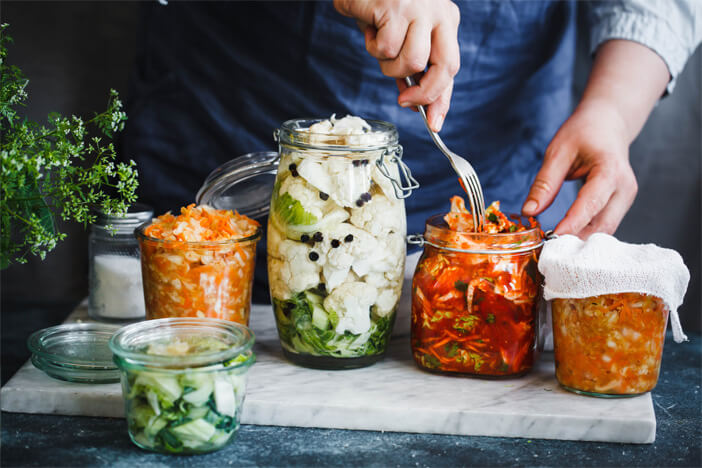Kitchen Hacks: freezing and storing food

Introduction
A few decades ago, it was normal to extend the shelf life of food by marinating it or through special storage. This was the only way it was possible to survive the winter or times of food shortage. Nowadays however we can shop anywhere, any time and most foods are available all year around.
However, the question of how we can best store food is still topical. In the following article you can read about the advantages of storing your food and discover tips and tricks for making your food last longer.
Reasons for storing certain foods
Less effort
You can simply cook a little more on some days and then freeze the leftovers for another day. This means you don´t have to shop and cook on the other days, saving you a lot of time and effort.
In case of emergency
Bottlenecks can also occur in the deliveries to our supermarkets. There are various scenarios in which this may occur, from natural disasters to pandemics. These cases, however, occur very rarely so you shouldn’t panic and start hoarding your food. However having food in storage can help you to overcome such supply problems.
Saves money
If you know how to store your food safely, you can buy in bulk and benefit from economies of scale. You can also take advantage of discount offers.
Good for the planet
By storing your food, you don’t throw anything away. What you don’t eat straight away gets stored. This results in less wastage.
What types of storage are there?

You can store your food in the following places:
- Freezer
- Fridge
- Cellar
- Pantry
Below you can find out which foods are best stored where.
Everything you need to know about freezing
Freezing is a great way to extend the shelf life of your food. In addition to fruit, you can freeze meat, vegetables and some dairy products. This is also possible for completely pre-cooked meals. Read on to find out what happens when you freeze food and what tips you should follow when freezing and defrosting.
Hacks for freezing
- Before freezing, you should clean the food well and if necessary peel and core it.
- Portion the food prior to freezing. You can cut fruit up into pieces. If you want to freeze yoghurt or other more liquid foods, you can use ice cube moulds to portion.
- When you freeze food, do so in airtight containers, such as freezer bags, if possible. Remove any excess air before you freeze.
- Most foods, such as milk, expand when frozen. To prevent the packaging from bursting open, you should make sure that there is enough room for the food to expand. Try to use flat rather than tall containers for freezing. This allows the mass to expand upwards more easily and keeps the pressure down.
- Freeze the food as soon as possible after purchase.
- If you put too many foods in the freezer at once, the cooling process slows down, causing both the shelf life and quality to suffer.
- To keep your freezer organised you can label your dishes e.g. with Post-Its showing date and content.
- Dishes containing mayonnaise or cream should not be frozen as they will curdle and become inedible.
Things to consider when freezing
| wdt_ID | Food | Durability in Freezer | Note: |
|---|---|---|---|
| 1 | Meat | 8-12 months | The fresher the meat and the lower the freezing temperatures, the better the quality of the meat. |
| 2 | Fish | 4 months | Before freezing, immerse the fish in salt water to give it a protective layer of ice. |
| 3 | Vegetables | 11-15 months | The firmer the vegetables, the better they can be frozen. Vegetables with a high water content (e.g. celery, cucumber, lettuce, cabbage, radish, tomato) are not suitable for freezing. Blanch the vegetables briefly before freezing (i.e. heat them for a few minutes in almost boiling water / steam). |
| 4 | Fruits | 11-15 months | Citrus fruits do not freeze well. Very ripe fruit is not ideal for freezing as it becomes very mushy after thawing, but you can puree it and make a delicious smoothie. |
| 5 | Butter | 6-9 months | Unsalted butter tends to lose its taste, so you should not freeze it for more than 6 months. Salted butter generally retains its taste longer, so you can freeze it for up to 9 months. |
| 6 | Milk & Cream | 2-3 months | After defrosting, always shake or stir to prevent sedimentation. Note that whipped cream cannot be whipped well after freezing. |
| 7 | Yohgurt | 1-2 months | Stir after defrosting. Natural yoghurt will taste slightly sour after freezing. To avoid this, you could add some honey or vanilla beforehand. |
| 8 | Cheese | 2-3 months |
Stir the cream cheese after defrosting. You can heat soft cheese slightly while stirring it to give it a consistency similar to that before freezing. |
| 9 | Eggs | 12 months | You can freeze eggs raw or cooked, but never freeze them in their shells as they will crack. |
| 10 | Bread | 1-3 months | Very well suited for freezing. Sliced bread is best toasted briefly after thawing. If you don't want individual slices to freeze together, you can put a piece of waxed paper in between each slice. |
What happens during the freezing process?
The main reason against freezing some foods is the formation of ice crystals. As soon as air comes to the surface of a food in the freezer, the water it contains often comes out in the form of ice crystals. This process dehydrates and discolours the food. This process also destroys the cellular structure and thus the consistency and shape of the food. This is also the reason why creamy or liquid foods (cottage cheese, quark, sour cream) are not well suited for freezing. Fortunately, there is a wide variety of foods that are suitable for freezing.
Are vitamins lost during freezing?

It is a common misconception that foods that have been frozen are less healthy. Vitamins are not automatically lost when food is frozen. However, to ensure that vitamins are preserved, it is important that food is frozen as quickly as possible. The longer you wait, the greater the loss of quality. Frozen vegetables and fruit found in the supermarket are therefore particularly rich in vitamins because they are processed and frozen particularly quickly after harvesting.
Hacks for defrosting
- If you have frozen an entire dish, make sure it is cooked thoroughly once it has defrosted
- You should not heat defrosted food more than once
- Season the food again after defrosting and cooking, as some flavour will be lost during the freezing process.
What belongs in the refrigerator?

As you probably already know, you can store almost all foods in the refrigerator. The refrigerator has several compartments. Above the vegetable compartment it is coldest, while in other places it is considerably warmer.
| Food | Temperature | Note |
|---|---|---|
| Meat & Fish | 2°C | The best place in the refrigerator for fish and meat is above the fruit and vegetable compartment, because that is where the refrigerator temperature is lowest. |
| Fruit & vegetables | 8°C | Often there is an extra compartment for fruit and vegetables at the bottom of the fridge. The glass plate, which is often placed above it, ensures that the temperature is maintained. |
| Dairy products | 5°C | These foods belong in the middle compartments of your fridge. |
| Eggs | 8°C | The refrigerator door is ideal for storing eggs, which is why it often has a special compartment for them. |
Do you always have to stick to the best before date?
You do not have to throw food away as soon as it reaches its best-before date. There is a period of time during which the food can still be safely consumed. So see it as more of a guide than a hard and fast rule. Many foods are still edible despite having exceeded their best-before date, and do not need to be disposed of.
So before you go throwing away your food, you should check whether it has really gone bad. You can rely on your own senses. First see if any mould is clearly visible. If not, you can smell and then taste. If you do not notice anything unusual, you can eat the food even after the best-before date has passed.
So help to counteract food waste!
Fridge hacks

- Cut avocados stay green longer if you do not remove the stone.
- Fresh herbs should be stored like flowers in a glass of fresh water.
- Peeled onions will stay fresh for longer if you rub their cut surface with a little butter or oil. Then seal them in a small container and put them in the fridge.
- For optimum storage, you can wrap lettuce in a damp kitchen towel with highly diluted vinegar and then place it in the vegetable compartment of the fridge. This keeps it fresh and preserves the nutrients for as long as possible.
- You should remove the greenery from carrots and other root vegetables before storing them, as this removes moisture from the vegetables.
Avoid germs in the fridge
A study by Jeon, Chun and Kim from 2013 shows that in many households the bacteria cultures found in the refrigerator are almost identical to those found on the toilet. The bacteria in the refrigerator are caused, among other things, by the soil hanging on fresh fruit or by the damp back wall of the refrigerator. It is therefore important to clean it every four weeks. To do this, you should remove all food and the glass plates. Then you can clean the fridge with a cloth, some water and detergent until it is as good as new.
Which food should not be stored in the refrigerator?
- Tomatoes: They lose their aroma in the cold and should not be stored together with other fruits and vegetables. This is because they release ethylene (a plant hormone), which accelerates the ripening process of other fruits and vegetables.
- Tropical fruits (e.g. bananas, avocados, pineapples): These fruits are very sensitive to the cold due to their origin and therefore do not belong in the refrigerator.
What is best stored in the cellar?
If you live in a house with a cellar, you can store apples there. These use up their water reserves at very low temperatures (for example in the refrigerator) and become wrinkly. They should therefore be stored in a place with high humidity. If you don’t have a cellar, it is also fine to store the apples outside the refrigerator.
Onions, garlic and potatoes should also be stored in a dark cellar or a dark corner of your kitchen (e.g. in a lightproof container). If kept near the window they will begin to sprout shoots.
You can also store canned foods, jams, preserved fruit or vegetables and drinks in the cellar.
Pickling and preserving foods

The method of preserving involves fruit or vegetables being heated and then preserved in an airtight jar. For example, in the autumn you can preserve apples, from which you can then conjure up a delicious apple sauce. It is important that the jars you use for storing are completely air tight.
Storage in the pantry
Some foods have a long shelf life, even without being stored in a specially refrigerated place. These foods can then be stored in a cupboard at 15-20°C. It is important that the place is dark and dry. Here you can store foods such as flour, sugar, rice, pasta and other dry products.
Tips for the pantry
Move newly bought items to the back of the shelf so that you automatically reach for the older goods first.
What is the best way to store open packages?

- As a general rule, you should decant food out of opened packages into air tight containers. You can use tupperwares, for example.
- Before storing vegetables in the refrigerator, you should remove the plastic film in which they are packaged. This is because water drops can collect underneath, which has a negative effect on the shelf life.
- Once the packaging has been removed, you can store the vegetables in the top shelf of the fridge.
Conclusion

As you can see, there are many advantages to storing food correctly. For a healthy diet, the storage, location, temperature and packaging of foods (especially fresh foods) all play an important role. Now you know what you should store where, you can use these tips and tricks to protect your wallet and strengthen your immune system in the long run.
Frequently asked questions and answers
Yes, if you want to extend the shelf life of your bread, you can do so by freezing it. As well as bread you can also freeze similar products such as wraps, tortillas and rolls.
The most suitable meals for freezing are those that can be easily divided into portions and that are made of ingredients that can be easily frozen. However, apart from a few exceptions, you can basically freeze any meals. The great result of this is that you save a lot of time and money.
Most people use freezer bags or plastic tupperware containers simply because they are not aware of the alternatives. However, contrary to expectations, glass is a well-suited replacement for when you don’t want to use plastic. Although we have all heard the story of the forgotten glass bottle that exploded in the freezer, this does not actually have anything to do with the glass itself. In principle, any conventional glass container with a screw cap is suitable, as long as you always leave some room and don’t fill the container all the way up to the top.
Sources
- Jeon, Y-S., Chun, J. & Kim, B-S. 2013. Identification of Household Bacterial Community and Analysis of Species Shared with Human Microbiome. Current Microbiology 67(5), 557-563
- Heiss, R. & Eichner, K. 2002. Haltbarmachen von Lebensmitteln: Chemische, physikalische und mikrobiologische Grundlagen der Qualitätserhaltung. 4. Auflage. Berlin Heidelberg New York: Springer
- Kreutzberger, S. & Thurn, V. 2012. Die Essensvernichter: Warum die Hälfte aller Lebensmittel im Müll landet und wer dafür verantwortlich ist. 1. Auflage. Köln: Kiepenheuer & Witsch
- Pfitzenmaier, B., Baden-Württemberg Stiftung & Universität Ulm 2016. Informationen und Tipps zur Ernährung von Kindern: Komm mit in das gesunde Boot. Stuttgart: Habé Offset GmbH
- Sauter, A., Winkler, G. & Wildt, B. 2007. Zur Lagerung von Lebensmitteln in privaten Haushalten. Ernährung – Wissenschaft und Praxis 1, 252–257



